The Definitive Guide To Getting Google Sitelinks

As a marketer, you know the importance of strong search engine rankings.
This is how you get highly targeted organic traffic for months and even years on autopilot.
While rankings are important, you also need more people to click on your sites in search engine results.
One way to increase your CTR is with Google Sitelinks.
But what are Google Sitelinks? How can they help your site? And most importantly, how do you get them?
In this guide, I will show you the answers to all these questions, and more.
Let’s get started:
What are Sitelinks?
Google Sitelinks are little sub-listings that appear under the first result in the search result. Usually when searching for brands.
You must have come across to them on number of occasions. This is what they look like:
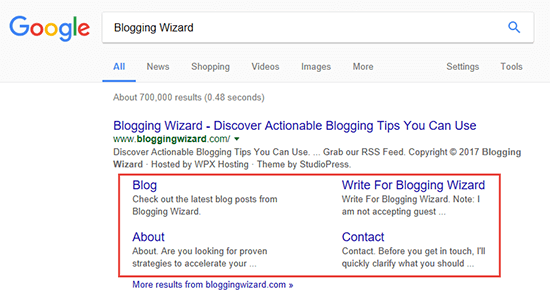
The four links under BloggingWizard.com along with the “More results from bloggingwizard.com” link are called “Sitelinks”.
Note: Open up Google Search in a new tab and search for Blogging Wizard to see a live example.
The purpose of Sitelinks is to help users navigate around your website. A user searching for “Blogging Wizard” might not necessarily want to see the homepage. Instead, they might be interested in heading directly to the blog page or the about page.
Sitelinks remove one step from this navigation process by placing important links right within the search results.
In a nutshell, they direct users to the best results in the shortest amount of time. And they make your site more prominent in search results, which is important for branding purposes.
Sitelinks have been around for nearly a decade. They first made an appearance around 2005. By 2007, they were a regular feature in search results.
This is what they used to look like in 2007:

Since then, they’ve gone through several iterations to get to what you see today.
And Google has also reduced the number of Sitelinks from a maximum of twelve to six.
The point is, the number, type and design of Sitelinks will keep changing over time. The optimization methods to get Sitelinks, however, will largely remain the same.
Sitelinks aren’t displayed for every website
If you search for a slightly obscure or poorly optimized site, there is a good chance Google won’t show Sitelinks for it.
And for some sites, it might even go beyond the regular 2/4/6-pack of Sitelinks to show a search box, like they do for AboveTheLaw.com:

We only show Sitelinks for results when we think they’ll be useful to the user. If the structure of your site doesn’t allow our algorithms to find good Sitelinks, or we don’t think that the Sitelinks for your site are relevant for the user’s query, we won’t show them.
From the above, we can say that Google might not show Sitelinks due to two reasons:
- The site structure doesn’t allow algorithms to find good Sitelinks
- The Sitelinks aren’t relevant to the user’s query
While you can’t control what users search for, you can design your site in a way to improve Sitelink discovery.
Which is what we will focus on in this guide.
But first: why exactly are Sitelinks actually important?
Let’s find out:
Why are Google Sitelinks important?
For searchers, Sitelinks save time and provide relevant results.
But what benefit are they to you?
1. Sitelinks improve CTR (click-through rates)
Besides rankings, your CTR is one of the biggest factors in successfully generating organic traffic.
On average, the first three results account for nearly 55% of all clicks.

These numbers do fluctuate over time. But, let’s use them as an example:
If a keyword gets 10,000 searches each month, this means that the first result gets 3,124 clicks.
Now imagine that the first result also gets Sitelinks. Since the Sitelinks now dominate the top half of the page (i.e. above the fold), the first result gets 20% extra clicks.
This translates into an additional 2,000 clicks each month – pretty good, right?!
In fact, one case study by PPC-Hero found that Sitelinks increased CTR by almost 64%.

Keep in mind that Sitelinks also show up in paid search results. One study found a direct correlation between sitelink visibility and the CTR. After the advertiser stopped showing Sitelinks, CTR plunged from over 20% to nearly 10%.
The number of leads reduced accordingly.

The lesson: if you want more people to click on your site in search results or ads, get Sitelinks.
2. Sitelinks build more trust and credibility
Sitelinks are an important metric to determine the trustworthiness of a website.
When you see Sitelinks on a website, it is a sign that Google trusts that website enough to give them Sitelinks.
If you were to search for an obscure, unpopular site with poor trust ratings; chances are you wouldn’t see Sitelinks.
What about a site with the opposite characteristics? Chances are you’ll see Sitelinks.
Understand that Google knows Sitelinks take up nearly the entire above the fold screen real estate. This pushes all search results further down the fold.
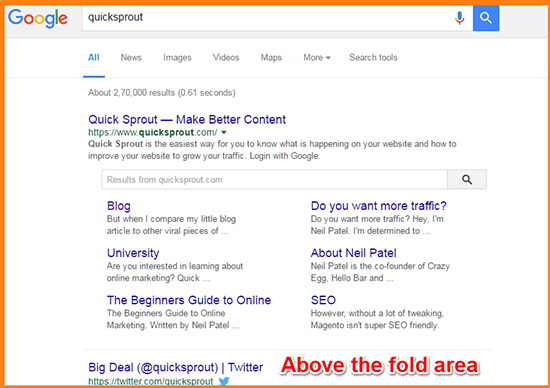
Since Google is committed to giving its users the best possible experience, it wouldn’t want to promote an untrustworthy link above the fold.
Google’s algorithm isn’t perfect, so it does make mistakes. But, it gets better all the time.
3. Sitelinks increase your brand and product awareness
Sitelinks usually link out to the most important pages on your site (from Google’s perspective), taking into account the number of internal/external links.
More often than not, these will be your ‘about’ or ‘product’ pages.
This makes Sitelinks a great way to educate people about your products, and improve brand awareness.
For example, when you search for Tim Ferriss’ “FourHourWorkWeek”, you see links to his podcast and the book that made him famous:

4. Sitelinks allow users to browse deeper pages
When a user visits your website, chances are they will browse through the homepage, product and service pages.
In total they might visit 4-5 pages of your website before they decide to leave.
Let me ask you:
Are they going to visit your most popular blog post? Or will they dig around to find the resources page that gives you your best conversions?
Probably not.
With Sitelinks, however, these popular links will show up in search results, driving traffic to your most important pages.
For example, Noah Kagan’s website, OkDork, has Sitelinks that show his most popular blog posts, a welcome guide for new users, his about page and a link to his free marketing toolkit:

This helps drive traffic to pages that actually deliver results (leads/subscribers) instead of simply directing people to the home page.
How to get Google Sitelinks for your website
There is no direct way to get Sitelinks for your website. You can’t just log into Google’s Search Console (Previously Webmaster Tools), flick a switch and get Sitelinks.
As things stand right now:
- Sitelinks are automated
- Sitelinks are created through website best practices
- Google doesn’t tell you how to create Sitelinks or control their appearance directly
Unfortunately, there are no fixed steps that you can follow to get Sitelinks on your website, but you can follow a process to increase your chances of getting Sitelinks.
Here’s how to get started:
1. Make sure that your website’s name is unique
The first step in getting Sitelinks is to make sure that you use a unique brand name for your site.
For example, if your website is called ‘The ice cream company’ it is likely that it will never gain first result on the first page because the term is too generic.
There could be thousands of companies that make ice cream all around the world. How can Google figure out which one is yours?

Instead, if you choose a unique name, it’d be much easier to rank and get Sitelinks.
For instance, take the example of QuickSprout. It is a unique name and no one is using it apart from Neil Patel.
So Google is sure that when people are searching for QuickSprout, they mean Neil’s website:
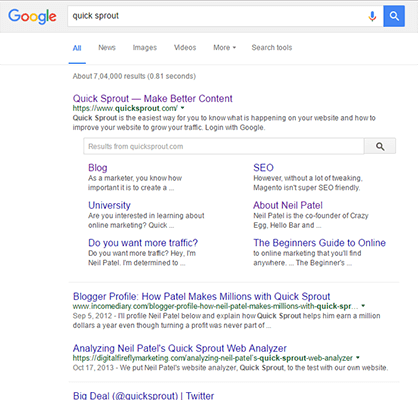
And not one of these:

In rare cases, brand names will qualify for the first page result even though they have generic name. Apple is a great example of this.
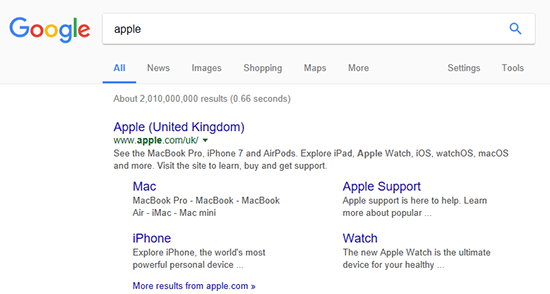
Based on the intent of users Google knows people who are searching for ‘Apple’ want to know about the company Apple and not the fruit.
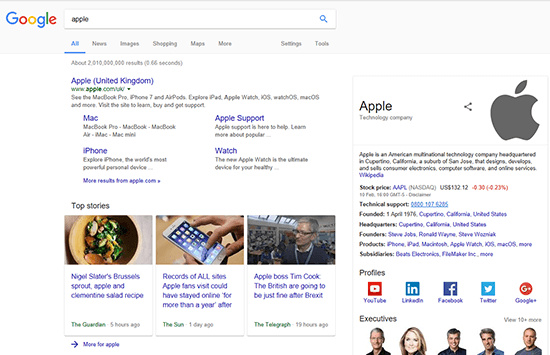
But this example only works because it’s Apple – smaller brands don’t usually have that luxury where generic brand names are concerned.
I’m not suggesting you change your website/brand name just to get Sitelinks. It’s a lot of effort to go to, and as your brand grows, the chance of getting Sitelinks grows too.
But, if you are at the stage of choosing your domain name, or deciding on a name for your business – avoid using keyword matching domains. Go for something more unique.
2. Add structured data to your Website
Structured data helps Google understand your website, and your organisation more effectively.
If you haven’t heard of this before, it’s more commonly known as rich snippets or schema.
And while typically associated with things like review snippets, and recipe snippets, you can do a lot more with structured data.
Essentially, you can add some code that tells Google which menu to consider for Sitelinks. You can also specifify your about page, contact page, enable breadcrumbs and a Sitelinks search box.
Here’s some good news:
If you use WordPress, you can install a plugin called Schema Pro (aff) that will handle all of this for you.
You can use it for all types of structured data, and it has a setup wizard so it’s extremely easy to setup (even if you’re not a coder.)
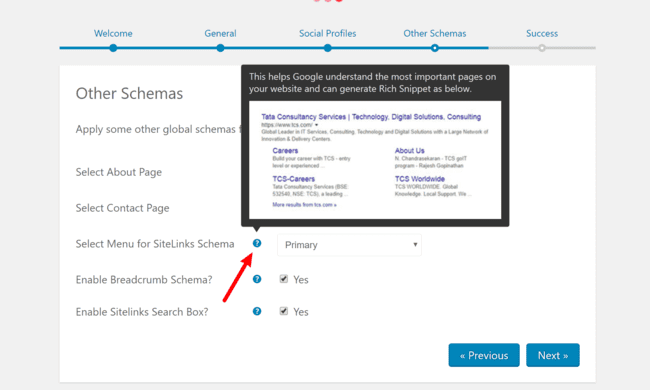
On top of this, you can also add article schema automatically to all of your blog posts without adding any weird boxes on the front end. It’s pretty neat and it’s what I use on Blogging Wizard.
And for those of you who work with clients, be sure to check out Schema Pro’s white label feature.
3. Ensure your website’s structure and navigation is crystal clear
Websites that have clear hierarchy and structure are easy to crawl and navigate for Google. If Google can’t find all the pages on your site and understand their position relative to each other, it won’t be able to show Sitelinks.
What this means is to keep your homepage as the “root” page.
This is the most visited page and the starting point of navigation for your visitors. From this page, help visitors find other pages on your site.
Your site structure needs to be logical, intuitive and organized.
For example, if you sell toys, you could organize your navigation like this:
- Home page -> Boys Toys -> Ages 12-14 > Action Figures
Similarly, if you’re selling marketing guides, you could do something like this:
- Home page -> eBooks -> Content Marketing eBooks -> “Beginners Guide to Content Marketing”
At the same time, make sure that you have all the ‘standard’ pages for a website – Contact Us, About, Products, Privacy Policy, etc.
4. Rank #1 for your brand name in search results
Guess who deserves Sitelinks? The first search result, of course.
There is no second search result that gets Google Sitelinks. If you search for “New Yorker”, the NewYorker.com (the magazine) site gets Sitelinks, not NewYorker.de (a German fashion label) by virtue of its superior ranking.

Once you reach #1 position for your website name, it gets much easier to get Sitelinks.
5. Add a sitemap.xml file to your Google Search Console account
A sitemap helps Google crawl your site better.
It not only increases coverage of your webpages, but also defines the most important pages of your website.
Google responds on the basis of priority and the traffic you are receiving on your pages.
If you haven’t got an account, or added your website to your Google Search Console account – follow these steps.
Once you’re ready, here’s what to do next:
To add your sitemap, log into Google Search Console and click on your website. On the dashboard, click on the “Sitemaps” link.

On the next screen, click on “Add/Test Sitemap” (it’s in the right-hand corner). In the pop-up box, add the location of your sitemap (usually “sitename.com/sitemap.xml”).
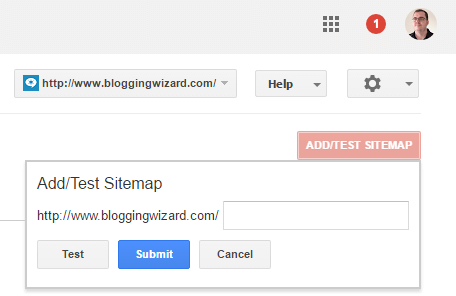
If you don’t have a sitemap yet, here’s how you can make one:
- Google XML Sitemaps plugin (for WordPress sites)
- XML-Sitemaps.com (for HTML websites)
Alternatively, if you use a WordPress plugin such as All in One SEO or Yoast SEO – both of those plugins have Sitemap functionality built in.
6. Build internal links
The jury is still out on how helpful internal links are for SEO, but they do tell Google what the most important pages on your site are.
For instance, if you repeatedly link to a product page, Google might take that as a signal for judging the importance of that page.
Here’s an example:
If you land on Tim Ferriss’ blog, FourHourWorkWeek, the top half of the screen is dominated by information about Tim’s podcast.

If you search “FourHourWorkWeek” on Google, the podcast also shows up among the Sitelinks:
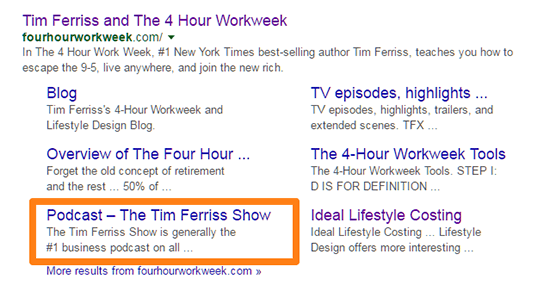
Google recognizes that the podcast page is important for FourHourWorkWeek. Not only is it frequented by actual users, it also has a lot of internal links pointing to it.
So, it appears that adding internal links to pages you want to show up in Sitelinks is a good idea.
You can track internal links from Google Webmaster Tools. To do this, log into your dashboard, then click on “Search Traffic -> Internal Links”.
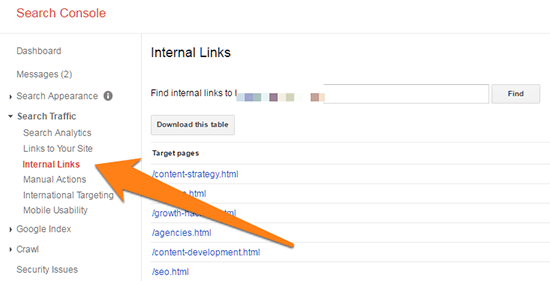
7. Crosscheck your page titles
The page title is one of the most important on-page SEO elements on your website.
Having the right page title is extremely crucial. Google looks at these titles to provide Sitelinks.
Make sure page titles are a short description of the pages themselves. These should be logical and in-line with visitor expectations.
This means you shouldn’t name your “About Us” page something like “Get to Know Us Better”. This might confuse Google and you might get absent or duplicate Sitelinks.
For example, Derek Halpern’s website, Social Triggers, has an about page as well as a page about Social Triggers, the blog.
These are the page titles, respectively:
- About – Social Triggers
- Here’s What Social Triggers is All About – Social Triggers
These are largely similar. This may confuse Google, which is likely why the Social Triggers’ sitelink features both these largely similar pages:
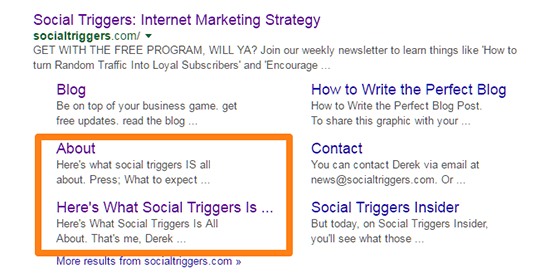
This effectively means that Derek is “wasting” a sitelink by pointing it to a similar page.
That said, from a copywriting perspective, I do like the sound of “Here’s What Social Triggers Is All About.”
8. Raise brand awareness
Raising your brand awareness is a never ending process. But how much is awareness is enough to get the Sitelinks?
Here is what Matt Cutts (Google’s former web spam head) had to say about it:
Make sure that enough people know about your website. You want to be a reputable website and you want people to find out about your website because we don’t do it for every single query.
You need to spread your brand name and make it reputable. There are a lot of ways to go about it.
For example, you could start guest blogging on popular sites in your niche, make yourself available for interviews, release a free tool that gives your website credit – and plenty more.
Make your site popular so that people know your brand by name. This will increase the number of branded searches you get, further improving your chances of getting Sitelinks.
Important: You can’t demote Sitelinks anymore
For close to 9 years, Google allowed webmasters to “demote” Sitelinks from their Google Search Console account. These were the links that you didn’t want in your Sitelinks list.
All you had to do was enter the link you wanted to remove – and that was it.
This has changed now. On October 13, 2016, Google announced that it was removing this feature to “simplify things”. Google also added that its algorithm has gotten much better at finding, creating and showing relevant Sitelinks.
Here’s the exact quote:
We only show Sitelinks for results when we think they’ll be useful to the user. If the structure of your site doesn’t allow our algorithms to find good Sitelinks, or we don’t think that the Sitelinks for your site are relevant for the user’s query, we won’t show them. This process is completely automated. Sitelinks have evolved into being based on traditional web ranking, so the way to influence them is the same as other web pages.
And, Google also shared three best practices to improve Sitelinks discovery:
- Provide a clear structure for your website, using relevant internal links and anchor text that’s informative, compact and avoids repetition.
- Allow Google to crawl and index important pages within your site. Use Fetch and Render to check that they can be rendered properly.
- If you need to remove a page from search completely, use a “noindex” robots meta tag on that page.
In other words, instead of controlling Sitelinks yourself, you know have to leave it to Google and hope that its algorithm makes the right choice.
Final thoughts
It isn’t compulsory for every website to have Google Sitelinks but they are helpful if you can get them.
But it’s not the end of the earth if you don’t get them.
Follow the advice listed above then leave Google to it – eventually you’ll get Sitelinks.
Finally, if you found this post useful, check out our post on Featured Snippets. They’re a great way to leapfrog over your competitors.
Inside the post you’ll learn what they are, how to track them, and how to optimize your content to rank for them. If you’re still new to SEO, check out our beginner’s guide to search engine optimization.

